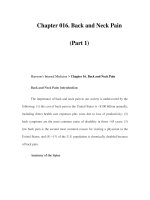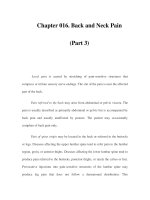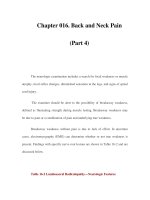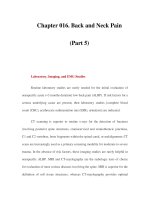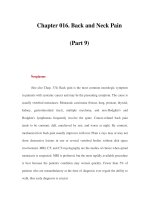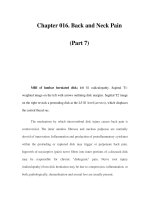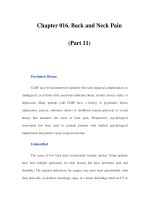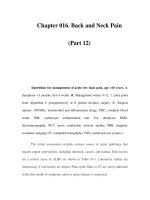Chapter 016. Back and Neck Pain (Part 8) ppsx
Bạn đang xem bản rút gọn của tài liệu. Xem và tải ngay bản đầy đủ của tài liệu tại đây (42.21 KB, 5 trang )
Chapter 016. Back and Neck Pain
(Part 8)
Degenerative Conditions
Lumbar spinal stenosis describes a narrowed lumbar spinal canal.
Neurogenic claudication is the usual symptom, consisting of back and buttock or
leg pain induced by walking or standing and relieved by sitting. Symptoms in the
legs are usually bilateral. Lumbar stenosis, by itself, is frequently asymptomatic,
and the correlation between the severity of symptoms and degree of stenosis of the
spinal canal is poor. Unlike vascular claudication, symptoms are often provoked
by standing without walking. Unlike lumbar disk disease, symptoms are usually
relieved by sitting. Focal weakness, sensory loss, or reflex changes may occur
when spinal stenosis is associated with radiculopathy. Severe neurologic deficits,
including paralysis and urinary incontinence, occur rarely. Spinal stenosis can be
acquired (75%), congenital, or due to a combination of these factors. Congenital
forms (achondroplasia, idiopathic) are characterized by short, thick pedicles that
produce both spinal canal and lateral recess stenosis. Acquired factors that
contribute to spinal stenosis include degenerative diseases (spondylosis,
spondylolisthesis, scoliosis), trauma, spine surgery, metabolic or endocrine
disorders (epidural lipomatosis, osteoporosis, acromegaly, renal osteodystrophy,
hypoparathyroidism), and Paget's disease. MRI provides the best definition of the
abnormal anatomy (Fig. 16-5).
Figure 16-5
Spinal stenosis. Sagittal T2 fast spin echo magnetic resonance imaging of a
normal (left) and stenotic (right) lumbar spine, revealing multifocal narrowing
(arrows) of the cerebrospinal fluid spaces surrounding the nerve roots within the
thecal sac.
Conservative treatment of symptomatic spinal stenosis includes
nonsteroidal anti-inflammatory drugs (NSAIDs), exercise programs, and
symptomatic treatment of acute pain episodes. Surgical therapy is considered
when medical therapy does not relieve symptoms sufficiently to allow for
activities of daily living or when significant focal neurologic signs are present.
Most patients with neurogenic claudication treated surgically experience at least
75% relief of back and leg pain. Up to 25% develop recurrent stenosis at the same
spinal level or an adjacent level 5 years after the initial surgery; recurrent
symptoms usually respond to a second surgical decompression.
Facet joint hypertrophy can produce unilateral radicular symptoms or signs
due to bony compression; symptoms are often indistinguishable from disk-related
radiculopathy. Stretch signs, focal motor weakness, hyporeflexia, or dermatomal
sensory loss may be present. Hypertrophic superior or inferior facets can be
visualized by x-rays, CT, or MRI. Surgical foraminotomy results in long-term
relief of leg and back pain in 80–90% of these patients. The usefulness of
therapeutic facet joint blocks for pain has not been rigorously studied.
Arthritis
Spondylosis, or osteoarthritic spine disease, typically occurs in later life and
primarily involves the cervical and lumbosacral spine. Patients often complain of
back pain that is increased with movement and associated with stiffness. The
relationship between clinical symptoms and radiologic findings is usually not
straightforward. Pain may be prominent when x-ray, CT, or MRI findings are
minimal, and large osteophytes can be seen in asymptomatic patients.
Radiculopathy occurs when hypertrophied facets and osteophytes compress nerve
roots in the lateral recess or intervertebral foramen. Osteophytes arising from the
vertebral body may cause or contribute to central spinal canal stenosis. Disc
degeneration may also play a role in reducing the cross-sectional area of the
intervertebral foramen; the descending pedicle may compress the exiting nerve
root. Rarely, osteoarthritic changes in the lumbar spine are sufficient to compress
the cauda equina.
Ankylosing Spondylitis
(See also Chap. 318) This distinctive arthritic spine disease typically
presents with the insidious onset of low back and buttock pain. Patients are often
males below age 40. Associated features include morning back stiffness, nocturnal
pain, pain unrelieved by rest, an elevated ESR, and the histocompatibility antigen
HLA-B27. Onset at a young age and back pain improving with exercise are
characteristic. Loss of the normal lumbar lordosis and exaggeration of thoracic
kyphosis develop as the disease progresses. Inflammation and erosion of the outer
fibers of the annulus fibrosus at the point of contact with the vertebral body are
followed by ossification and bony growth that bridges adjacent vertebral bodies
and reduces spine mobility in all planes. Radiologic hallmarks are periarticular
destructive changes, sclerosis of the sacroiliac joints, and bridging of vertebral
bodies to produce the fused "bamboo spine."
Stress fractures through the spontaneously ankylosed posterior bony
elements of the rigid, osteoporotic spine may produce focal pain, spinal instability,
spinal cord compression, or CES. Atlantoaxial subluxation with spinal cord
compression occasionally occurs. Ankylosis of the ribs to the spine and a decrease
in the height of the thoracic spine may compromise respiratory function. For many
patients, therapy with anti-tumor necrosis factor agents is effective in reducing
disease activity. Similar to ankylosing spondylitis, restricted movements may
accompany Reiter's syndrome, psoriatic arthritis, and chronic inflammatory bowel
disease.
